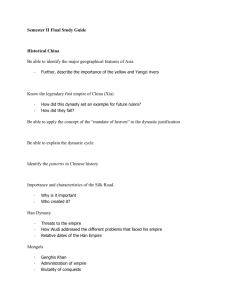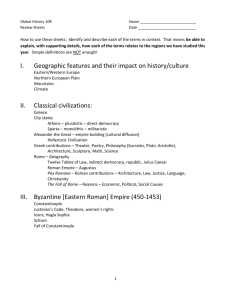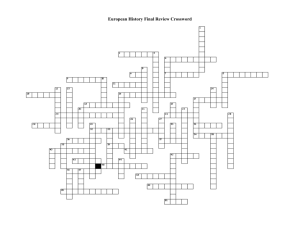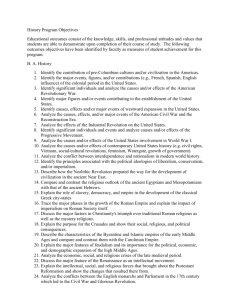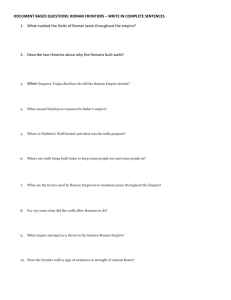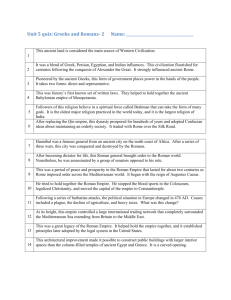CHAPTER 1 - Whittier Union High School District
advertisement
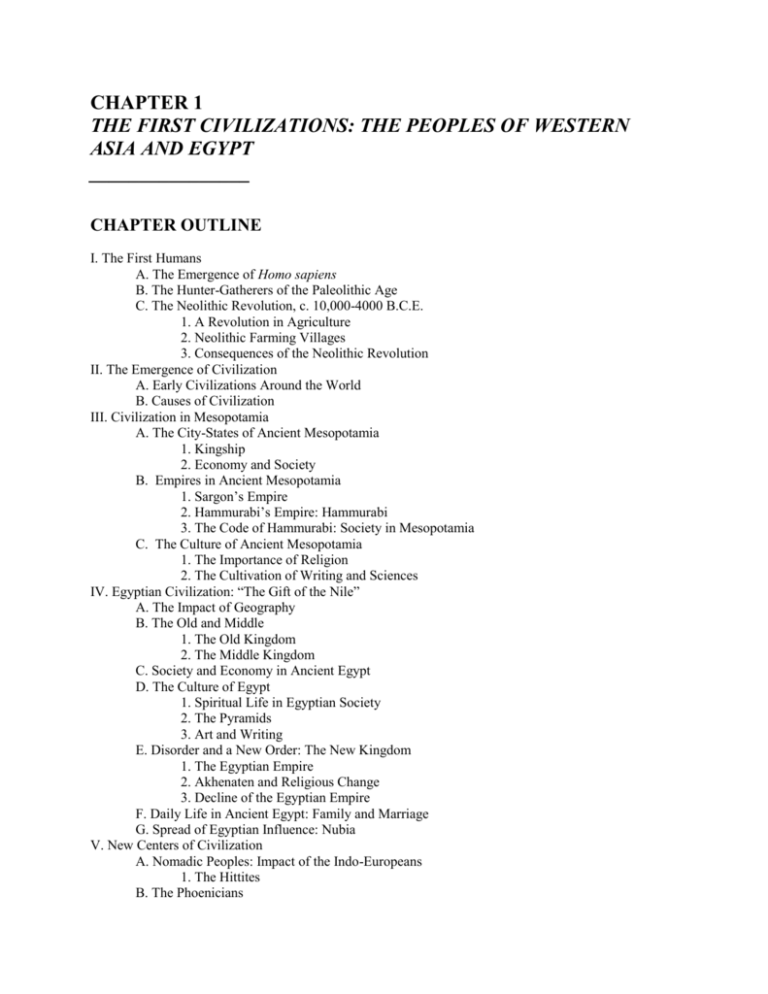
CHAPTER 1 THE FIRST CIVILIZATIONS: THE PEOPLES OF WESTERN ASIA AND EGYPT ________________ CHAPTER OUTLINE I. The First Humans A. The Emergence of Homo sapiens B. The Hunter-Gatherers of the Paleolithic Age C. The Neolithic Revolution, c. 10,000-4000 B.C.E. 1. A Revolution in Agriculture 2. Neolithic Farming Villages 3. Consequences of the Neolithic Revolution II. The Emergence of Civilization A. Early Civilizations Around the World B. Causes of Civilization III. Civilization in Mesopotamia A. The City-States of Ancient Mesopotamia 1. Kingship 2. Economy and Society B. Empires in Ancient Mesopotamia 1. Sargon’s Empire 2. Hammurabi’s Empire: Hammurabi 3. The Code of Hammurabi: Society in Mesopotamia C. The Culture of Ancient Mesopotamia 1. The Importance of Religion 2. The Cultivation of Writing and Sciences IV. Egyptian Civilization: “The Gift of the Nile” A. The Impact of Geography B. The Old and Middle 1. The Old Kingdom 2. The Middle Kingdom C. Society and Economy in Ancient Egypt D. The Culture of Egypt 1. Spiritual Life in Egyptian Society 2. The Pyramids 3. Art and Writing E. Disorder and a New Order: The New Kingdom 1. The Egyptian Empire 2. Akhenaten and Religious Change 3. Decline of the Egyptian Empire F. Daily Life in Ancient Egypt: Family and Marriage G. Spread of Egyptian Influence: Nubia V. New Centers of Civilization A. Nomadic Peoples: Impact of the Indo-Europeans 1. The Hittites B. The Phoenicians C. The Hebrews: The “Children of Israel” 1. The United Kingdom of Israel 2. The Divided Kingdom 3. The Spiritual Dimensions of Israel VI. The Rise of New Empires A. The Assyrian Empire 1. Assyrian Society 2. Assyrian Culture B. The Persian Empire 1. Cyrus the Great 2. Expanding the Empire 3. Governing the Empire 4. The Great King 5. Persian Religion CHAPTER 2 Ancient India ________________ CHAPTER OUTLINE I. Emergence of Civilization in India: Harappan Society A. A Land of Diversity B. Harappan Civilization: A Fascinating Enigma 1. Political and Social Structures 2. Harappan Culture C. A Lost Civilization? II. The Arrival of the Aryans in India A. The Early Aryans 1. Impact of the Greeks B. The Mauryan Empire C. Caste and Class: Social Structures in Ancient India 1. The Class System 2. The Jati D. Daily Life in Ancient India 1. The Family 2. Marriage 3. The Role of Women E. The Economy 1. Indian Farmers 2. Trade and Manufacturing III. Escaping the Wheel of Life: The Religious World of Ancient India A. Hinduism 1. Reincarnation 2. Hindu Gods and Goddesses B. Buddhism: The Middle Path 1. The Life of Siddhartha Gautama 2. Jainism 3. Ashoka, a Buddhist Monarch IV. The Rule of the Fishes: India after the Mauryas V. The Exuberant World of Indian Culture A. Literature B. Architecture and Sculpture C. Science CHAPTER 3 China in Antiquity _______________ CHAPTER OUTLINE I. The Dawn of Chinese Civilization A. The Land and People of China B. The Shang Dynasty (1500s-1000s B.C.E.) 1. Political Organization 2. Social Structures II. The Zhou Dynasty (1000s-200s B.C.E.) A. Political Structures 1. The Mandate of Heaven B. Economy and Society C. The Hundred Schools of Ancient Philosophy 1. Early Beliefs 2. Confucianism 3. Legalism 4. Daoism 5. Popular Beliefs III. The First Chinese Empire: The Qin Dynasty A. The Qin Dynasty (221-206 B.C.E.) 1. Political structures 2. Society and the Economy 3. Beyond the Frontier: The Nomadic Peoples and the Great Wall 4. The Fall of the Qin IV. Daily Life in Ancient China A. The Role of the Family B. Lifestyles C. Cities D. The Humble Estate: Women in Ancient China V. Chinese Culture A. Metalwork and Sculpture 1. Bronze Casting 2. The First Emperor’s Tomb B. Language and Literature C. Music CHAPTER 4 The Civilization of the Greeks ________________________ CHAPTER OUTLINE I. Early Greece A. Minoan Crete B. The First Greek State: Mycenae (1600-1100 B.C.E.) C. The Greeks in a Dark Age (c. 1100–c. 750 B.C.E.) 1. Homer and Homeric Greece 2. Homer’s Enduring Importance II. The Greek City-States (c. 750–c. 500 B.C.E.) A. The Polis 1. A New Military System: The Greek Way of War B. Colonization and the Growth of Trade C. Tyranny in the Greek Polis D. Sparta 1. The New Sparta 2. The Spartan State E. Athens 1. The Reforms of Solon 2. The Reforms of Cleisthenes F. Foreign Influence on Early Greek Culture III. The High Point of Greek Civilization: Classical Greece A. The Challenge of Persia B. The Growth of an Athenian Empire in the Age of Pericles C. The Great Peloponnesian War (431-404 B.C.E.) and the Decline of the Greek States D. The Culture of Classical Greece 1. The Writing of History 2. Greek Drama 3. The Arts: The Classical Ideal 4. The Greek Love of Wisdom E. Greek Religion F. Daily Life in Classical Athens 1. Economy and Lifestyle 2. Family and Relationships IV. The Rise of Macedonia and the Conquests of Alexander A. Alexander the Great 1. Alexander’s Conquests 2. The Legacy of Alexander V. The World of the Hellenistic Kingdoms A. Hellenistic Monarchies 1. The Seleucid Kingdom and India B. Political Institutions C. Hellenistic Cities D. The Importance of Trade E. Social Life: New Opportunities for Women F. Culture in the Hellenistic World 1. New Directions in Literature and Art 2. A Golden Age of Science 3. Philosophy: New Schools of Thought 4. Religion in the Hellenistic World CHAPTER 5 The First World Civilization: Rome, China, and the Emergence of the Silk Road ________ CHAPTER OUTLINE I. Early Rome and the Republic A. Early Rome B. The Roman Republic, 509 B.C.E. 1. The Roman Conquest of Italy 2. The Roman State C. The Roman Conquest of the Mediterranean (264–133 B.C.E.) 1.Evolution of the Roman Army D. The Decline and Fall of the Roman Republic (133–31 B.C.E.) 1. Growing Unrest and a New Role for the Roman Army 2. The Collapse of the Republic II. The Roman Empire at Its Height A. The Age of Augustus (31 B.C.E.–14 C.E.) B. The Early Empire (14-180) 1. The Five Good Emperors (96-180) 2. Frontiers and the Provinces 3. Prosperity in the Early Empire C. Culture and Society in the Roman World 1. Roman Literature 2. Roman Art 3. Roman Law 4. The Roman Family 5. Slaves and Their Masters 6. Imperial Rome 7. Disaster in Southern Italy III. Crisis and the Late Empire A. Crisis in the Third Century B. The Late Roman Empire 1. The Reforms of Diocletian (284-305) and Constantine (306-337) 2. The End of the Western Empire IV. Transformation of the Roman World: The Development of Christianity A. The Origins of Christianity B. The Spread of Christianity C. The Triumph of Christianity V. The Glorious Han Empire (202 B.C.E-221 C.E.) A. Confucianism and the State B. The Economy C. Imperial Expansion and the Origins of the silk Road D. Social Changes E. Religion and Culture F. The Decline and Fall of the Han CHAPTER 6 The Americas ___________ CHAPTER OUTLINE I. The Peopling of the Americas A. The First Americans II. Early Civilizations in Central America A. The Olmecs: In the Land of Rubber. B. The Zapotecs C. Teotihuacán: America’s First Metropolis D. The Maya 1. Origins 2. Political Structures 3. Mayan Religion 4. Mayan Hieroglyphs and Calendars 5. The Mystery of Mayan Decline E. The Aztecs 1. Politics 2. Social Structures 3. Land of the Feathered Serpent: Aztec Religion and Culture 4. Art and Culture III. The First Civilizations in South America A. Caral B. Moche 1. Environmental Problems C. The Inka 1. The Four Quarters: Inka Politics and Society 2. Inka Culture IV. Stateless Societies in the New World A. The Eastern Woodlands B. Cahokia C. The “Ancient Ones”: The Anasazi D. South America: The Awawak E. Amazonia CHAPTER 7 THE WORLD OF ISLAM _________________________________ CHAPTER OUTLINE I. The Rise of Islam A. The Role of Muhammad B. The Teachings of Muhammad II. The Arab Empire and Its Successors A. Creation of an Empire B. The Rise of the Umayyads (661-750) C. The Abbasids (750) 1. Abbasid Rule 2. Instability and Division D. The Seljuk Turks E. The Crusades F. The Mongols G. Andalusia: A Muslim Outpost in Europe 1. A Time of Troubles III. Islamic Civilization A. Political Structures B. The Wealth of Araby: Trade and Cities in the Middle East C. Islamic Society D. The Culture of Islam 1. Philosophy and Science 2. Islamic Literature 3. Islamic Art and Architecture CHAPTER 8 EARLY CIVILIZATIONS IN AFRICA _______________________________________________ CHAPTER OUTLINE I. The Emergence of Civilization A. The Land B. Kush C. Axum and Saba D. The Sahara and Its Environs 1. The Garamantes E. East Africa II. The Coming of Islam A. African Religious Beliefs Before Islam B. The Arabs in North Africa C. The Kingdom of Ethiopia: A Christian Island in a Muslim Sea D. East Africa: The Land of Zanj E. The States of West Africa 1. Ghana 2. Mali III. States and Stateless Societies in Central and Southern Africa A. The Congo River Valley B. Zimbabwe C. Southern Africa 1. The Khoi and the San IV. African Society A. Urban Life B. Village Life C. The Role of Women D. Slavery V. African Culture A. Painting and Sculpture B. Music C. Architecture D. Literature CHAPTER 9 THE EXPANSION OF CIVILIZATION IN SOUTHERN ASIA ____________________________________________________________________________ CHAPTER OUTLINE I. The Silk Road II. India After the Mauryas A. The Gupta Dynasty: A New Golden Age? B. The Transformation of Buddhism 1. Theravada 2. Mahayana C. The Decline of Buddhism in India II. The Arrival of Islam A. The Empire of Mahmud of Ghazni B. The Delhi Sultanate C. Tamerlane III. Society and Culture A. Religion B. Economy and Daily Life 1. Agriculture 2. Foreign Trade 3. Science and Technology C. The Wonder of Indian Culture 1. Art and Architecture 2. Literature 3. Music IV. The Golden Region: Early Southeast Asia A. Paddy Fields and Spices: The States of Southeast Asia 1. The Mainland States 2. The Malay World 3. The Role of India B. Daily Life 1. Social Structures 2. Women and the Family C. World of the Spirits: Religious Belief D. Expansion into the Pacific CHAPTER 10 THE FLOWERING OF TRADITIONAL CHINA ___________________________________________________________ CHAPTER OUTLINE I. China after the Han II. China Reunified: The Sui, the Tang, and the Song A. The Sui Dynasty (581-618) B. The Tang Dynasty (618-907) C. The Song Dynasty (960-1279) D. Political Structures: The Triumph of Confucianism 1. Equal Opportunities in China: The Civil Service Examination 2. Local Government E. The Economy 1. The Land Reform 2. The Urban Economy 3. The Silk Road 4. The Maritime Route F. Society in Traditional China 1. The Rise of the Gentry 2. Village China 3. The Role of Women III. Explosion in Central Asia: The Mongol Empire A. Mongol Rule in China B. The Mongols’ Place in History IV. The Ming Dynasty (1369-1644) B. The Voyages of Zhenghe C. An Inward Turn V. In Search of the Way A. The Rise and Decline of Buddhism and Daoism 1. The Sinification of Buddhism 2. Buddhism Under Threat B. Neo-Confucianism: The Investigation of Things 1. The School of Mind VI. The Apogee of Chinese Culture A. Literature 1. The Importance of Poetry 2. Popular Culture 3. The Chinese Novel B. Art CHAPTER 11 The East Asian Rimlands: Early Japan, Korea, and Vietnam ____________________________________________ CHAPTER OUTLINE I. Japan: Land of the Rising Sun A. A Gift from the Gods: Prehistoric Japan B. The Rise of the Japanese State 1. Emulating the Chinese model 2. The Nara Period 3. The Heian Period 4. The Kamakura Shogunate and After C. Economic and Social Structures 1. Trade and Manufacturing 2. Daily Life 3. The Role of Women D. In Search of the Pure Land: Religion in Early Japan E. Sources of Traditional Japanese Culture 1. Literature 2. Art and Architecture F. Japan and the Chinese Model II. Korea: Bridge to the East A. The Three Kingdoms B. The Rise of the Koryo Dynasty C. Under the Mongols III. Vietnam: The Smaller Dragon A. The Rise of Great Viet 1. The Chinese Legacy B. Society and Family Life CHAPTER 12 The Making of Europe ____________________________ CHAPTER OUTLINE I. The Emergence of Europe in the Early Middle Ages A. The New Germanic Kingdoms 1. The Kingdom of the Franks 2. The Society of the Germanic Peoples B. The Role of the Christian Church 1. The Organization of the Church 2. The Monks and Their Missions C. Charlemagne and the Carolingians 1. The Significance of Charlemagne D. The World of Lords and Vassals 1. Invasions of the Ninth and Tenth Centuries 2. The Development of Fief-Holding 3. The Practice of Fief-holding 4. The Manorial System II. Europe in the High Middle Ages A. Land and People 1.The New Agriculture 2. Daily Life of the Peasantry 3. The Nobility of the Middle Ages B. The New World of Trade and Cities 1. The Revival of Trade 2. Trade Outside Europe 3. The Growth of Cities 4. Daily Life in the Medieval City C. Evolution of the European Kingdoms 1. England in the High Middle Ages 2. Growth of the French Kingdom 3. The Lands of the Holy Roman Empire 4. The Slavic Peoples of Central and Eastern Europe 5. The Development of Russia: Impact of the Mongols D. Christianity and Medieval Civilization 1.Reform of the Papacy 2. The Church Supreme: The Papal Monarchy 3. New Religious Orders and New Spiritual Ideals 4. Popular Religion in the High Middle Ages E. The Culture of the High Middle Ages 1. The Rise of Universities 2. The Development of Scholasticism 3. Romanesque Architecture 4. The Gothic Cathedral III. Medieval Europe and the World A. The First Crusades B. The Later Crusades C. Effects of the Crusades CHAPTER 13 The Byzantine Empire and Crisis and Recovery in the West _____________________________________________________________________________ CHAPTER OUTLINE I. From Eastern Roman to Byzantine Empire A. The Reign of Justinian (527-565) 1. The Codification of Roman Law 2. The Empress Theodora 3. The Emperor’s Building Program B. A New Kind of Empire 1. Problems of the Seventh Century 2. The Byzantine Empire in the Eight Century 3. Intellectual Life 4. Life in Constantinople: The Importance of Trade II. The Zenith of Byzantine Civilization (750-1025) A. The Beginning of Revival B. The Macedonian Dynasty 1. Economic and Religious Policies 2. Political and Military Achievements III. Decline and Fall of the Byzantine Empire (1025-1453) A. New Challenges and New Responses 1. A Christian Schism 2. Islam and the Seljuk Turks 3. A New Dynasty B. Impact of the Crusades 1. The Latin Empire of Constantinople 2. Revival of the Byzantine Empire C. The Ottoman Turks and the Fall of Constantinople IV. The Crises of the Fourteenth Century A. The Black Death: From Asia to Europe 1. Role of the Mongols 2. The Black Death in Europe B. Economic Dislocation and Social Upheaval C. Political Instability 1. The Hundred Year’s War 2. Political Disintegration D. The Decline of the Church 1. The Great Schism and Cries for Reform V. Recovery: The Renaissance A. The Intellectual Renaissance B. The Artistic Renaissance C. The State in the Renaissance 1. The Italian States 2. Western Europe 3. Central and Eastern Europe CHAPTER 14 New Encounters: The Creation of a World Market __________________________________________________________________ CHAPTER OUTLINE I. An Age of Exploration and Expansion A. Islam and the Spice Trade B. The Spread of Islam in West Africa 1. The Kingdom of Songhai C. A New Player: Europe 1. The Motives 2. The Means II. The Portuguese Maritime Empire A. The Portuguese in India B. The Search for Spices III. Spanish Conquests in the “New World” A. The Voyages B. The Conquests C. Governing the Empire IV. The Impact of European Expansion A. New Rivals 1. Europeans in Asia 2. Europeans in the Americas V. Africa in Transition A. The Portuguese in Africa B. The Dutch in South Africa C. The Slave Trade 1. Origins of Slavery in Africa 2. Growth of the Slave Trade 3. The Middle Passage 4. Sources for Slaves 5. The Effects of the Slave Trade D. Political and Social Structures in a Changing Continent VI. Southeast Asia in the Era of the Spice Trade A. The Arrival of the West B. State and Society in Precolonial Southeast Asia 1. Religion and Kingship 2. The Economy 3. Society CHAPTER 15 Europe Transformed: Reform and State Building _________________________________________________________________ CHAPTER OUTLINE I. The Reformation of the Sixteenth Century A. Background to Protestant Reformation 1. The Growth of State Power 2. Social Change in the Renaissance 3. The Impact of Printing 4. Prelude to Reformation 5. Church and Religion on the Eve of the Reformation B. Martin Luther (1483-1546) and the Reformation in Germany 1. Politics and Religion in the German Reformation C. The Spread of the Protestant Reformation 1. John Calvin (1509-1564) and Calvinism 2. The English Reformation 3. The Anabaptists D. The Social Impact of the Protestant Reformation E. The Catholic Reformation 1. The Society of Jesus 2. A Reformed Papacy 3. The Council of Trent II. Europe in Crisis, 1560-1650 A. Politics and the Wars of Religion in the Sixteenth Century 1. The French Wars of Religion (1562-1598) 2. Philip II (1556-1598) and Militant Catholicism 3. The England of Elizabeth (1558-1603) B. Economic and Social Crises, 1560-1650 1. Population Decline 2. Witchcraft Mania 3. Economic Trends in the Seventeenth Century C. Seventeenth-Century Crises: Revolution and War 1. The Thirty Years’ War (1618-1648) 2. A Military Revolution? III. Response to Crisis: Absolutism A. France Under Louis XIV (1643-1715) 1. Political Institutions 2. The Economy and the Military B. Absolutism in Central and Eastern Europe 1. Prussia 2. Austria 3. From Muscovy to Russia IV. England and Limited Monarchy A. Conflict Between King and Parliament B. Civil War and Commonwealth C. Restoration and a Glorious Revolution V. The Flourishing of European Culture A. Art: The Baroque B. Art: Dutch Realism C. A Golden Age of Literature in England CHAPTER 16 The Muslim Empires ___________________________ CHAPTER OUTLINE I. The Ottoman Empire A. The Rise of the Ottoman Turks B. Expansion of the Empire 1. The Fall of Constantinople 2. The Advance into Western Asia and Africa 3. Turkish Expansion in Europe C. The Nature of Turkish Rule 1. The Role of the Sultan 2. The Harem 3. Administration of the Government D. Religion and Society in the Ottoman World 1. The Treatment of Minorities 2. Social Classes 3. The Position of Women E. The Ottomans in Decline F. Ottoman Art 1. Architecture 2. Textiles II. The Safavids A. The Rise of the Safavids B. Decline of the Dynasty C. Safavid Politics and Society D. Safavid Art and Literature III. The Grandeur of the Mughals A. The Mughal Dynasty: A “Gunpowder Empire”? B. Akbar and Indo-Muslim Civilization 1. Religion 2. Society and the Economy C. Twilight of the Mughals 1. The Reign of Shan Jahan (1628-1658) 2. Rule of Aurangzeb (1658-1707) 3. Decline of the Mughals D. The Impact of Western Power in India 1. Economic Difficulties 2. Resistance to the British E. Society under the Mughals 1. The Position of Women 2. Muslims and Hindus 3. The Economy F. Mughal Culture 1. Architecture 2. Painting 3. Literature CHAPTER 17 The East Asian World ____________________________ CHAPTER OUTLINE I. China at Its Apex A. From the Ming to the Qing 1. First Contacts with the West 2. The Ming brought to earth B. The Greatness of the Qing (Pure) 1. The Reign of Kangxi (1661-1722) 2. The Reign of Qianlong (1736-1795) C. Qing Politics 1. China on the Eve of the Western Onslaught II. Changing China A. The Population Explosion B. Seeds of Industrialization C. Daily Life in Qing China 1. The Family 2. The Role of Women D. Cultural Developments 1. The Rise of the Chinese Novel 2. The Art of the Ming and the Qing III. Tokugawa Japan A. The Three Great Unifiers B. Opening to the West 1.Expulsion of the Christians C. The Tokugawa “Great Peace” 1. Daimyo and Samurai 2. Seeds of Capitalism 3. Land Problems D. Life in the Village 1. The role of women E. Tokugawa Culture 1. The Literature of the New Middle Class 2. Tokugawa Art IV. Korea: The Hermit Kingdom A. Yi dynasty 1. Vietnam: The Perils of Empire CHAPTER 18 The West on the Eve of a New World Order _________________________________________________________ CHAPTER OUTLINE I. Toward a New Heaven and a New Earth: An Intellectual Revolution in the West A. The Scientific Revolution 1. Toward a New Heaven: A Revolution in Astronomy 2. Toward a New Earth: Descartes and Rationalism 3. Europe, China, and the Scientific Revolution B. Background to the Enlightenment C. The Philosophes and Their Ideas 1. Montesquieu (1689-1755) 2. Voltaire (1694-1778) 3. Diderot (1713-1784) 4. Toward a New “Science of Man” 5. The Later Enlightenment 6. The “Woman’s Question” in the Enlightenment D. Culture in an Enlightened Age 1. High Culture 2. Popular Culture II. Economic Changes and the Social Order A. New Economic Patterns B. European Society in the Eighteenth Century III. Colonial Empires and Revolution in the Western Hemisphere A. The Society of Latin America 1. The Economic Foundations 2. The State and Church in Colonial Latin America B. British North America 1. The American Revolution 2. Birth of a New Nation IV. Toward a New Political Order and Global Conflict A. Prussia: The Army and the Bureaucracy B. The Austrian Empire of the Habsburgs C. Russia under Catherine the Great (1762-1796) D. Enlightened Absolution Reconsidered E. Changing Patterns of War: Global Confrontation V. The French Revolution, 1789 A. Background to the French Revolution 1. Social Structure of the Old Regime 2. Other Problems Facing the French Monarchy B. From Estates-General to National Assembly C. Destruction of the Old Regime D. The Radical Revolution 1. A Nation in Arms 2. Reign of Terror 3. Equality and Slavery: Revolution in Haiti E. Reaction and the Directory (1795-1799) VI. The Age of Napoleon A. The Rise of Napoleon B. Domestic Policies C. Napoleon’s Empire 1. The Grand Empire: from 1807 to 1812 2. The Fall of Napoleon CHAPTER 19 THE BEGINNINGS OF MODERNIZATION: INDUSTRIALIZATION AND NATIONALISM IN THE NINETEENTH CENTURY _________________________________ CHAPTER OUTLINE I. The Industrial Revolution and Its Impact A. The Industrial Revolution in Great Britain 1. Origins 2. Changes in Textile Production 3. Other Technological Changes 4. The Industrial Factory B. The Spread of Industrialization 1. Industrialization on the Continent 2. The Industrial Revolution in the United States C. Limiting the Spread of Industrialization to the Rest of the World D. Social Impact of the Industrial Revolution 1. Population Growth and Urbanization 2. The Industrial Middle Class 3. The Industrial Working Class 4. Efforts at Change II. The Growth of Industrial Prosperity A. New Products B. New Patterns C. Emergence of a World Economy D. The Spread of Industrialization E. Women at Work: New Job Opportunities F. Organizing the Working Class 1. Marxist Theory 2. Socialist Parties 3. Revisionism and Trades Unions III. Reaction and Revolution: The Growth of Nationalism A. The Conservative Order B. Forces for Change C. Revolution and Reform, 1832-1848 D. The Revolutions of 1848 1. Revolution in Central Europe 2. Revolts in the Italian States E. Nationalism in the Balkans: The Ottoman Empire and the Eastern Question 1. The Crimean War IV. National Unification and the National State, 1848-1871 A. The Unification of Italy B. The Unification of Germany C. Nationalism and Reform: The European National State at Mid-Century 1. Great Britain 2. France 3. The Austrian Empire 4. Russia V. The European State, 1871-1914 A. Western Europe: The Growth of Political Democracy B. Central and Eastern Europe: Persistence of the Old Order C. International Rivalry and the Winds of War D. The Ottoman Empire and Nationalism in the Balkans 1. Crises in the Balkans, 1908-1913 CHAPTER 20 THE AMERICAS AND SOCIETY AND CULTURE IN THE WEST CHAPTER OUTLINE I. Latin America in the Nineteenth and Early Twentieth Century A. The Wars for Independence 1. Nationalistic Revolts in Latin America 2. The Efforts of Bolivar and San Martin 3. Independence and the Monroe Doctrine B. The Difficulties of Nation Building 1. Political Difficulties 2. Economic Patterns 3. Social Conditions 4. Church and State C. Tradition and Change in the Latin American Economy and Society D. Political Change in Latin America II. The North American Neighbors: The United States and Canada A. The Growth of the United States 1. Slavery and the Coming of War 2. The Civil War B. The Rise of the United States 1. Prosperity and Progressivism 2. The United States as a World Power C. The Making of Canada III. The Emergence of Mass Society A. The New Urban Environment B. The Social Structure of Mass Society C. The Experiences of Women 1. Marriage and the Family 2. The Movement for Women’s Rights D. Education in an Age of Mass Society E. Leisure in an Age of Mass Society IV. Cultural Life: Romanticism and Realism in the Western World A. The Characteristics of Romanticism B. A New Age of Science C. Realism in Literature and Art V. Toward the Modern Consciousness: Intellectual and Cultural Developments A. A New Physics B. Sigmund Freud and Psychoanalysis C. The Impact of Darwin: Social Darwinism and Racism 1. Anti-Semitism D. The Culture of Modernity CHAPTER 21 THE HIGH TIDE OF IMPERIALISM _______________________________________________ CHAPTER OUTLINE I. The Spread of Colonial Rule A. The Motives B. The Tactics II. The Colonial System A. The Philosophy of Colonialism 1. Assimilation and Association 2. Colonialism in Action III. India under the British Raj A. Colonial Reforms B. The Cost of Colonialism IV. Colonial Regimes in Southeast Asia A. “Opportunity in the Orient”: The Colonial Takeover in Southeast Asia B. The Nature of Colonial Rule 1. Administration and Education 2. Economic Development 3. Colonialism and the Countryside V. Empire Building in Africa A. The Growing European Presence in West Africa B. Imperialist Shadow over the Nile C. Arab Merchants and European Missionaries in East Africa D. Bantus, Boers, and British in the South E. The Scramble for Africa F. Colonialism in Africa 1. Indirect Rule 2. The British in East Africa 3. British Rule in South Africa 4. Direct Rule, French Style 5. Women in Colonial Africa VI. The Emergence of Anticolonialism A. Stirrings of Nationhood B. Traditional Resistance: A Precursor to Nationalism 1. The Sepoy Rebellion CHAPTER 22 SHADOWS OVER THE PACIFIC: EAST ASIA UNDER CHALLENGE ____________________________________________ CHAPTER OUTLINE I. The Decline of the Manchus A. Opium and Rebellion 1. The Opium War (1839-1842) 2. The Taiping Rebellion B. Efforts at Reform C. The Climax of Imperialism 1. Opening the Door 2. The Boxer Rebellion D. The Collapse of the Old Order 1. The Rise of Sun Yat-sen (1866-1925) 2. The Revolution of 1911 II. Chinese Society in Transition A. Obstacles to Industrialization B. The Impact of Imperialism C. Daily Life in Qing China 1. Changing Roles for Women III. A Rich Country and a Strong State: The Rise of Modern Japan A. An End to Isolation B. The Meiji (“enlightened rule”) Restoration (1868) 1. The Transformation of Japanese Politics 2. The Constitution of 1890 3. Meiji Economics 4. Building a Modern Social Structure 5. Traditional Values and Women’s Rights C. Joining the Imperialist Club D. Japanese Culture in Transition E. The Meiji Restoration: A Revolution from Above 1. Sources of Japanese Uniqueness 2. Fusing East and West CHAPTER 23 THE BEGINNING OF THE TWENTIETH-CENTURY CRISIS: WAR AND REVOLUTION CHAPTER OUTLINE I. The Road to World War I A. Nationalism and Internal Dissent B. Militarism C. The Outbreak of War: Summer of 1914 1. The Assassination of Francis Ferdinand, June 28, 1914 2. Impact of the Schlieffen Plan II. The Great War A. 1914-1915: Illusions and Stalemate B. 1916-1917: The Great Slaughter C. The Widening of the War 1. A Global Conflict 2. Entry of the United States D. The Home Front: The Impact of Total War 1. Political Centralization and Economic Regimentation 2. Public Order and Public Opinion 3. Women in the War Effort III. War and Revolution A. The Russian Revolution 1. The March Revolution 2. Lenin and the Bolshevik Revolution 3. Civil War, 1918-1921 B. The Last Year of the War 1. The Casualties of the War C. The Peace Settlement 1. Peace Aims 2. The Treaty of Versailles 3. The Other Peace Treaties IV. An Uncertain Peace A. The Impact of World War I B. The Search for Security 1. The French Policy of Coercion 4. The Hopeful Years (1924-1929) C. The Great Depression 1. Causes 2. Repercussions D. The Democratic States 1. Great Britain 2. France 3. Germany 4. United States E. Socialism in Soviet Russia 1. New Policies 2. The Struggle for Power V. In Pursuit of a New Reality: Intellectual and Cultural Trends A. Nightmares and New Visions 1. The Dada Movement: Dadaism 2. Surrealism and Modern Architecture B. Probing the Unconscious CHAPTER 24 NATIONALISM, REVOLUTION, AND DICTATORSHIP: AFRICA, ASIA, AND LATIN AMERICA FROM 1919 TO 1939 _____________________________________________________________________________ CHAPTER OUTLINE I. The Rise of Nationalism A. Modern Nationalism 1. Religion and Nationalism 2. Independence or Modernization? The Nationalist Quandary B. Gandhi and the Indian National Congress 1. Nonviolent Resistance 2. New Leaders and New Problems C. The Nationalist Revolt in the Middle East 1. Decline of the Ottoman Empire 2. Mustapha Kemal (1881-1938) and the Modernization of Turkey 3. Modernization in Iran 4. Nation-Building in Iraq 5. The Rise of Arab Nationalism and the Problem of Palestine D. Nationalism and Revolution in Asia and Africa 1. Lenin and the East 2. The Appeal of Communism II. Revolution in China A. Mr. Science and Mr. Democracy: The New Culture Movement B. The Nationalist-Communist Alliance C. The Nanjing Republic 1. The Best of East and West D. “Down with Confucius and Sons”: Economic, Social, and Cultural Change in Republican China 1. Social Changes 2. A New Culture? III. Japan between the Wars A. Experiment in Democracy B. A Zaibatsu Economy C. Shidehara Diplomacy 1. The Rise of Militant Nationalism IV. Nationalism and Dictatorship in Latin America A. A Changing Economy 1. The Role of the Yankee Dollar B. The Effects of Dependency 1. Argentina 2. Brazil 3. Mexico C. Latin America Culture CHAPTER 25 THE CRISIS DEEPENS: WORLD WAR II _____________________________________________________ CHAPTER OUTLINE I. Retreat from Democracy: Dictatorial Regimes A. Stepping Back from Democracy B. The Birth of Fascism C. Hitler and Nazi Germany 1. Hitler and the Early Nazi Party 2. The Rise to Power 3. The Nazi State, 1933-1939 D. The Stalinist Era in the Soviet Union E. The Rise of Militarism in Japan II. The Path to War A. The Path to War in Europe 1. A Diplomatic Revolution: Scrapping the Treaty of Versailles 2. The Takeover of Czechoslovakia 3. Poland B. The Path to War in Asia 1. Japanese Aggression in China 2. Advance to the South III. World War II A. Europe at War 1. The Problem of Britain 2. Invasion of the Soviet Union B. Japan at War C. The Turning Point of the War, 1942–1943 1. North Africa and the Eastern Front 2. Asia D. The Last Years of the War 1. Allied Advances in Europe 2. Defeat of Japan IV. The New Order A. The New Order in Europe 1. The Nazi Empire 2. Plans for an Aryan Racial Empire 3. Use of Foreign Workers B. The Holocaust 1. The SS and the Einsatzgruppen 2. The Death Camps 3. The Other Holocaust C. The New Order in Asia 1. Japanese Policies 2. Resentment and Resistance V. The Home Front A. Mobilizing the People 1. The Soviet Union 2. The United States 3. Germany 4. Japan B. The Bombing of Cities 1. Luftwaffe Attacks 2. The Bombing of Germany 3. The Bombing of Japan: The Atomic Bomb VI. Aftermath: The Cold War A. The Costs of World War II B. The Allied War Conferences 1. The Conference at Tehran, November 1943 2. The Yalta Conference, February 1945 3. The Potsdam Conference, July 1945 4. Emergence of the Cold War CHAPTER 26 EAST AND WEST IN THE GRIP OF THE COLD WAR ____________________________________________________________________ CHAPTER OUTLINE I. The Collapse of the Grand Alliance A. Soviet Domination of Eastern Europe B. Descent of the Iron Curtain C. The Truman Doctrine D. The Marshall Plan E. Europe Divided 1. The Berlin Airlift 2. NATO and the Warsaw Pact 3. Who Started the Cold War? II. Cold War in Asia A. The Chinese Civil War 1. The Communist Triumph B. The New China C. The Korean War D. Conflict in Indochina III. From Confrontation to Coexistence A. Ferment in Eastern Europe 1. The Hungarian Revolution 2. Different Roads to Socialism B. Rivalry in the Third World C. The Cuban Missile Crisis and the Move Toward Détente D. The Sino-Soviet Dispute E. The Second Indochina War 1. The Role of China 2. The Quest for Peace 3. The Fall of Saigon IV. An Era of Equivalence A. The Brezhnev Doctrine B. An Era of Détente C. Renewed Tensions in the Third World D. Countering the Evil Empire E. Toward a New World Order CHAPTER 27 BRAVE NEW WORLD: COMMUNISM ON TRIAL _____________________________________________________________________________________ CHAPTER OUTLINE I. The Postwar Soviet Union A. From Stalin to Khrushchev 1. Stalinism in Action 2. The Rise and Fall of Khrushchev B. The Brezhnev Years (1964-1982) 1. A Controlled Society 2. A Stagnant Economy 3. An Aging Leadership C. Cultural Expression in the Soviet Bloc D. Social Changes in the Soviet Union and Eastern Europe 1. Education 2. The New Elite II. The Disintegration of the Soviet Empire A. The Gorbachev Era 1. The Beginning of the End 2. Evaporation of an Empire B. Eastern Europe: From Satellites to Sovereign Nations C. Eastern Europe: From Soviet Satellites to Sovereign Nations IV. The East is Red: China Under Communism A. New Democracy B. The Transition to Socialism C. The Great Proletarian Cultural Revolution D. From Mao to Deng E. Incident at Tiananmen Square F. A Return to Confucius? V. “Serve the People”: Chinese Society Under Communism A. Economics in Command 1. Agricultural Reform 2. Evaluating the Four Modernizations B. Social Problems 1. Women and the Family 2. Lifestyle Changes C. China’s Changing Culture 1. Art and Music 2. Literature CHAPTER 28 EUROPE AND THE WESTERN HEMISPHERE SINCE 1945 ____________________________________________________________________________ CHAPTER OUTLINE I. Recovery and Renewal in Europe A. Western Europe: The Triumph of Democracy 1. France: From De Gaulle to New Uncertainties 2. From West Germany to One Germany 3. The Decline of Great Britain B. Eastern Europe After Communism 1. The Disintegration of Yugoslavia C. The Unification of Europe 1. The European Union 2. Toward a United Europe II. The Emergence of the Superpower: The United States A. American Politics and Society through the Vietnam Era B. The Shift Rightward After 1973 III. The Development of Canada IV. Latin America Since 1945 A. The Threat of Marxist Revolutions 1. The Cuban Revolution 2. Chile’s Marxist Adventure 3. Nicaragua: From the Somozas to the Sandinistas B. Nationalism and the Military: The Example of Argentina and Brazil 1. Argentina 2. Brazil C. The Mexican Way V. Society and Culture in the Western World A. The Emergence of a New Society 1.A Society of Consumers B. A Revolt of Sexual Mores C. Youth Protest and Student Revolts D. Women in the Postwar Western World 1. The Feminist Movement: The Quest for Liberation 2. Transformation in Women’s Lives E. The Growth of Terrorism 1. Terrorist Attack on the United States 2. The West and Islam F. Guest Workers and Immigrants G. The Environment and the Green Movements H. Western Culture Since 1945 1. Postwar Literature 2. Postmodernism I. Trends in Art 1. Art in the Age of Commerce J. The World of Science and Technology K. Varieties of Religious Life 1. Fundamentalism L. The Explosion of Popular Culture CHAPTER 29 CHALLENGES OF NATION BUILDING IN AFRICA AND THE MIDDLE EAST _____________________________________________________________________________________ CHAPTER OUTLINE I. Uhuru: The Struggle for Independence in Africa A. The Colonial Legacy B. The Rise of Nationalism II. The Era of Independence A. Pan-Africanism and Nationalism: The Destiny of Africa B. Dream and Reality: Political and Economic Conditions in Contemporary Africa 1. Africa in the Cold War 2. The Population Bomb C. The Search for Solutions 1. Tanzania: An African Route to Socialism 2. Kenya: The Perils of Capitalism 3. Angola and Ethiopia: Experiments in Marxism 4. South Africa: An End to Apartheid 5. Nigeria: A Nation Divided 6. Tensions in the Desert 7. Central Africa: Cauldron of Conflict D. Sowing Seeds of Democracy 1. The African Union: A Glimmer of Hope III. Continuity and Change in Modern African Societies A. Education B. Urban and Rural Life C. African Women 1. Urban Women D. African Culture 1. Literature 2. Music E. Lost Souls at the Gate IV. Crescent of Conflict A. The Question of Palestine B. Nasser and Pan-Arabism 1. The United Arab Republic C. The Arab-Israeli Dispute 1. The Six-Day War 2. The Camp David Agreement 3. The PLO and the Intifada D. Revolution in Iran 1. The Fall of the Shah E. Crisis in the Gulf 1. The Vision of Saddam Hussein 2. Operation Desert Storm F. Conflicts in Afghanistan and Iraq V. Society and Culture in the Contemporary Middle East A. The Economics of Oil 1. Economics and Islam 2. Agricultural Policies 3. Migratory Workers 4. Challenges to Democracy B. The Islamic Revival 1. Modernist Islam 2. Return to Tradition C. The Role of Women D. Literature and Art 1. National Literature 2. Art and Music CHAPTER 30 TOWARD THE PACIFIC CENTURY? ______________________________________________ CHAPTER OUTLINE I. South Asia A. The End of the British Raj B. Independent India 1. An Experiment in Democratic Socialism 2. The Post-Nehru Era C. The Land of the Pure: Pakistan Since Independence D. Poverty and Pluralism in South Asia 1. The Politics of Communalism 2. The Economy 3. Caste, Class, and Gender E. South Asian Art and Literature Since Independence F. Gandhi’s Vision for India II. Southeast Asia A.The End of the Colonial Era B. In the Shadow of the Cold War 1. The Search for a New Political Culture 2. Sukarno and “Guided Democracy” C. Recent Trends: On the Path to Development 1.The Fall of the Suharto Regime 2. The Vietnamese Model 3. The Burmese Exception 4. Crisis and Recovery D. Regional Conflict and Cooperation: The Rise of ASEAN E. Daily Life: Town and Country in Contemporary Southeast Asia 1.Traditional Customs, Modern Values F. Cultural Trends G. A Region in Flux III. Japan: Asian Giant A.The Transformation of Modern Japan 1.The MacArthur Reforms 2. Japan in the Cold War 3. Politics and Government 4. Japan, Inc. 5. Atoning for the Past B. The Economy 1.The “Japanese Miracle” 2. A Miracle Tarnished C. A Society in Transition 1.The Pressure to Conform 2. The Demographic Crisis 3. Religion D. Japanese Culture IV. The Little Tigers A. South Korea: A Peninsula Divided B. Taiwan: The Other China C. Singapore and Hong Kong: The Littlest Tigers D. On the Margins of Asia: Postwar Australia and New Zealand E. Explaining the East Asian Miracle 1.The China Factor
